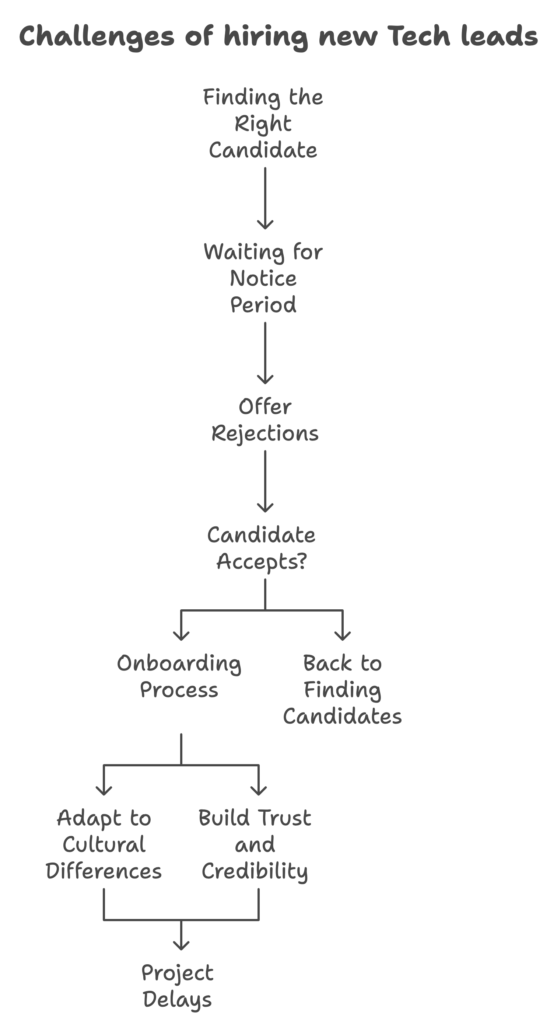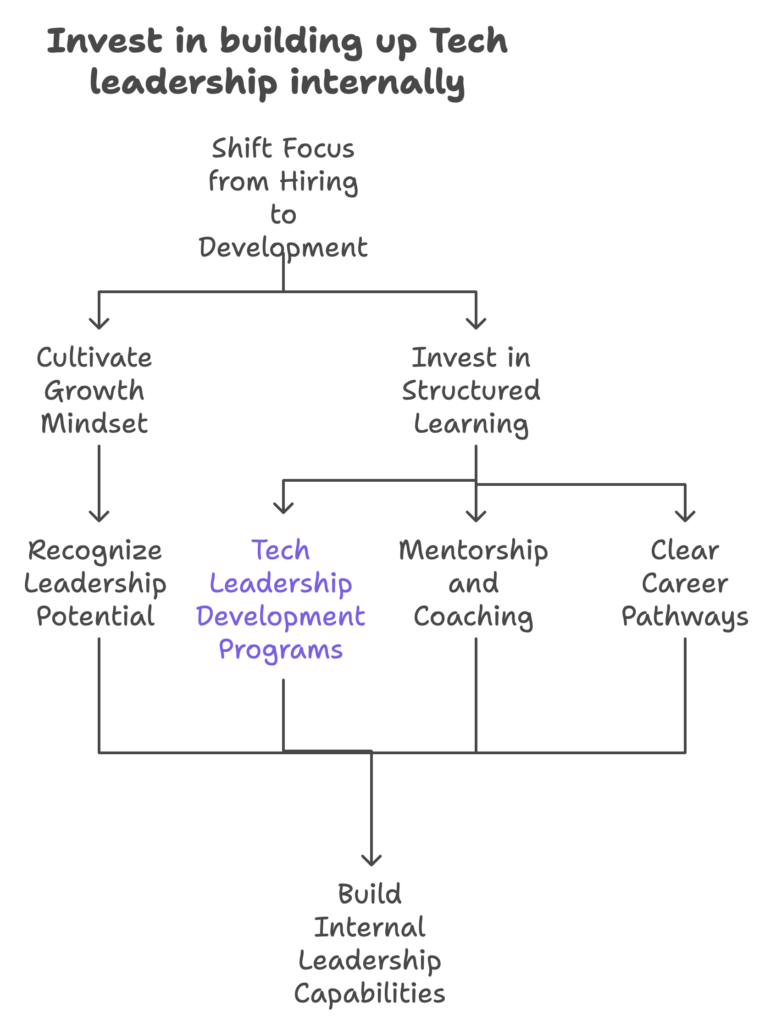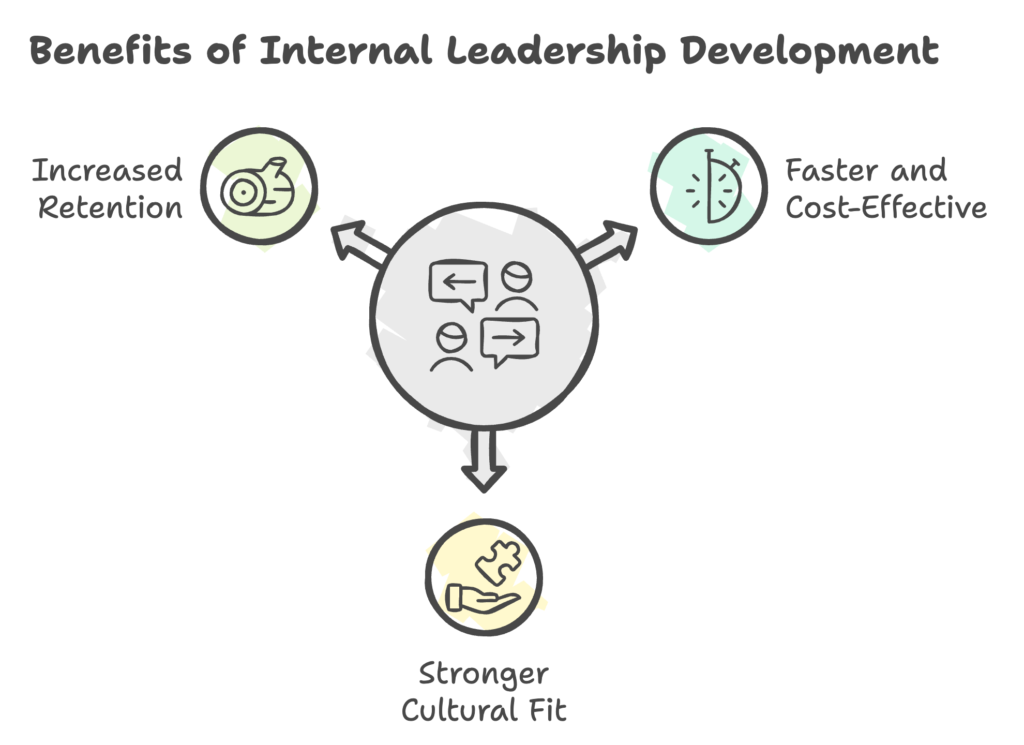Build Up Internal Tech Leadership: A Smarter Alternative to Hiring
Hiring tech leaders can be a daunting and slow process, often filled with challenges such as high competition and long notice periods. For instance, finding the right candidate can take months, and even then, only about 60% of those who accept offers actually join. These obstacles make hiring a less effective solution for addressing immediate leadership gaps.
In this blog, we’ll explore an additional and important solution: investing in the development of tech leadership from within your organization. By building internal capabilities, companies can enjoy faster, more cost-effective results while ensuring a stronger cultural fit.
We will start by looking at the challenges involved in hiring tech leaders and then discuss the merits of building capabilities internally, highlighting why this approach can be a more sustainable solution.
The Challenges of Hiring New Tech Leads
Hiring tech leaders is challenging, requiring significant time, energy, and resources. Even when a successful hire is made, it often takes months for the new leader to become effective. Let’s break down the challenges of relying on external hires:

Finding the Right Candidate Takes Time
From identifying the right person to evaluating their fit, the search process is often slow. The pool of experienced tech leaders is small, and even smaller when you consider those actively seeking new roles.
Waiting for Their Joining Date
Once you’ve made a hiring decision, there’s often a long wait for the candidate’s notice period to end. In regions like India, notice periods can last two to three months, delaying their start date and pushing back the timeline for the value they’re supposed to bring.
Offer Rejections at the Last Minute
Even after securing a candidate, offer rejections at the last minute are common—especially in competitive markets. It is often the case that only about 60% of people who accept an offer actually end up joining. This can leave companies scrambling, back at square one after months of effort and delays.
Hiring Tech Leads is Costly
The number of highly skilled tech leads actively seeking new roles is limited, making the talent pool small. This scarcity further complicates the hiring process and increases the costs required to get the right candidate in.
Tech leads also come at a premium because companies are competing fiercely to attract the best talent. The high demand for experienced tech leaders means that organizations must offer attractive packages and benefits, adding to the overall cost and making the hiring process highly competitive.
Onboarding New Tech Leads is Slow and Costly
Even when you manage to hire the right person, it can take three to six months for them to become fully effective. A newly hired tech leader at a mid-sized company would take several months to adjust to the company’s culture, understand the existing team dynamics, and build trust with key stakeholders. This onboarding process highlights the challenges of becoming effective quickly in a new environment. Here’s why:
- Cultural and Organizational Differences: Every organization operates differently. New hires must adapt to the company’s specific processes, tools, and culture, which takes time.
- Building Trust and Credibility: New tech leaders need to earn the trust of their teams and stakeholders. Building relationships and understanding team dynamics is a gradual process.
Because of these factors, the assumption that hiring new tech leadership will quickly solve problems is flawed. By the time they are fully onboarded and effective, valuable time is lost, and projects may face delays of up to nine months.
Investing in Building Capabilities Internally
Instead of relying solely on hiring, companies should shift their focus toward developing the capabilities of their existing employees. This involves embracing a growth mindset and investing in structured learning opportunities for internal talent.

Cultivating a Growth Mindset for Leadership Development
Many organizations see their people as static resources—hired for specific skills and stuck in those roles indefinitely. However, adopting a growth mindset changes this perspective. Employees have the potential to grow into new roles, develop new skills, and take on more responsibilities, including tech leadership positions.
Instead of seeing a Java developer as “just” a Java developer, leaders should look at their broader capabilities. For example, a developer who consistently builds strong stakeholder relationships and demonstrates an understanding of the business impact of their technical decisions could be recognized as having leadership potential. When a developer who exhibits these qualities is given more responsibility, such as leading a small team, it fast tracks their growth and helps the entire team around them.
Structured Learning and Growth Investments
To build internal leadership capabilities, companies need to proactively invest in structured learning and growth opportunities for their employees. This includes offering internal leadership development programs, providing mentorship and coaching for high-potential employees, and creating clear pathways for career growth. These initiatives shouldn’t be left solely to individual employees to pursue in their spare time. Companies must take responsibility for creating these opportunities, providing the resources and support necessary for success.
The Benefits of Building Internal Leadership
The benefits of investing in internal talent for leadership roles are clear:

- Faster and More Cost-Effective: Developing internal talent is both faster and less expensive than hiring externally. Employees already understand the company’s culture, systems, and processes, making the transition to leadership smoother and faster.
- Stronger Cultural Fit: Internal candidates are familiar with the company’s way of working and have established relationships. This familiarity reduces the time it takes for them to become productive in a leadership role.
- Increased Retention and Employee Satisfaction: Employees are more likely to stay with a company that invests in their growth and development. By offering clear career progression opportunities, companies can keep their best people engaged, motivated, and satisfied.
Conclusion: Embrace the Build Lever
The build lever isn’t just an alternative to hiring—it’s a strategic necessity for organizations looking to fill tech leadership gaps efficiently and effectively. While hiring will always be part of a company’s talent strategy, relying solely on external talent is a risky and costly approach. By investing in building tech leadership capabilities from within, companies can reduce costs, accelerate leadership development, and create a more engaged and fulfilled workforce.
Embrace the build lever, and you’ll not only close your leadership gaps faster but also create a more resilient and adaptable organization that’s ready for future challenges.
Subscribe to the Next Iteration Newsletter to get members only content and insights directly in your inbox!
